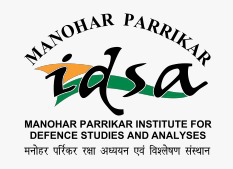
- This event has passed.
Report of talk by Shri Rajiv Malhotra on 3 March 2025 at MP-IDSA
March 3, 2025
Shri Rajiv Malhotra, a prominent Indian-American author, public intellectual, and founder of Infinity Foundation, who has significantly influenced discussions on India-US relations and Indian culture in the global context, spoke on ‘Trump and India’ at the talk held on 03 March 2025. The session was chaired by Ambassador Sujan R. Chinoy, Director General, MP-IDSA. Scholars of the Institute were in attendance.
Executive Summary
Shri Rajiv Malhotra characterised the Trump administration as strategically focused on dismantling the “deep state” and DEI initiatives while implementing corporate-style efficiency in government operations. He anticipated an “America First” approach that may include a pragmatic power-sharing arrangement with China and a strategic realignment with Russia. For India, he identified critical challenges: the country must transition from “renting out” tech talent to building indigenous technological capabilities, assert regional leadership more effectively, and strategically leverage its geography and Russia relationship in negotiations with the U.S.
Detailed Report
Ambassador Chinoy introduced the speaker Shri Rajiv Malhotra and highlighted his expertise on India-U.S. relations and the evolving global order, noting his background in technology and commitment to indigenous strategic thought.
Amb. Chinoy discussed how India has historically been interpreted through Western lenses for hundreds of years, particularly during colonisation, and emphasised the importance of now viewing India through its own cultural and strategic perspectives. He shared a personal anecdote about how Western scholars refused to provide endorsements for books focused on India’s strategic autonomy and Vedic foundations of Indian strategic thought, which challenged Western academic norms.
Shri Malhotra began by sharing his background as a computer scientist with early studies in artificial intelligence during the 1970s when the field was largely theoretical. After working as a technical expert in the industry with approximately 20 companies, he transitioned to working with a foundation focused on simulation spaces in the early 1990s.
The speaker discussed his observations from being granted access to Trump’s transition team in Washington during the days before the presidential inauguration. He characterised the Trump administration as strategic rather than chaotic, populated by young, sophisticated, and tech-savvy professionals who are likely to remain influential beyond a single term. He suggested that this could represent a 12-year political wave rather than a temporary shift, indicating that young people in Trump’s team who have already faced primaries, would contest future elections, and are very likely to win.
A central focus of the Trump administration, according to the speaker, was dismantling what they call the “deep state” and challenging diversity, equity, and inclusion (DEI) initiatives that he believed have undermined American competitiveness. He suggested that under Trump, with mass firings and implementation of corporate efficiency practices through the “Department of Government Efficiency (DOGE)” would lead to significant restructuring of government agencies.
The speaker predicted increased reliance on technology in governance, with formerly anti-Trump tech figures now aligning with the administration. They anticipate a government that is “smarter, more tech-driven” but potentially “less human,” with algorithms replacing human decision-making in many areas.
Regarding international relations, the speaker predicted an “America First” approach would lead to a strategic rebalancing where Russia might be approached differently than during previous administrations. Drawing historical parallels to the Nixon-Kissinger strategy of decoupling China from the USSR, he speculated that Trump might attempt to separate Russia from its alliance with China. He considered various scenarios for U.S.-China relations, including potential conflict but also the possibility of a pragmatic power-sharing arrangement where the two countries divide global influence. He suggested that Trump, as a “deal maker,” might be open to a duopoly agreement with China rather than sustained confrontation.
In terms of implications for India, the speaker identified several challenges and opportunities in this new landscape. He critiqued India’s approach of “renting out” its tech talent through outsourcing rather than building its own technological products and infrastructure. He suggested India should position its engineering workforce as a strategic asset in competition with China rather than merely seeking H-1B visas.
The speaker advised India to identify specific strategic “cards” it can bring to negotiations with the U.S., including potential influence in Bangladesh and other regional matters. He warned that India will likely face pressure to lower tariffs on American goods, which could disrupt local industries, and may experience pressure to purchase American weapons systems instead of Russian ones.
The speaker also noted that Christian right influences in the Trump administration might create tensions around religious missionary activities in India. He further mentioned that the aerospace sector will likely be prioritised, with potential opportunities for collaboration.
In the domain of technology and labour markets, the speaker raised concerns about rapid technological change causing labour market disruptions globally. He suggested that automation and Artificial Intelligence advancements are happening so quickly that job displacement and creation are occurring within 5-10 years rather than over generations, potentially leading to significant social disruption. He speculated this might even lead to arguments for depopulation as technological efficiency reduces the need for large human workforces.
Throughout the talk, he emphasised the need for strategic thinking about the intersection of technology, governance, and international relations in a rapidly changing global landscape.
Q&A Session
The Q&A session began with questions about Shri Malhotra’s characterisation of the “deep state” and its relationship to the Trump administration. Shri Malhotra clarified that every country needs a “deep state” as the infrastructure of machines, administration, and institutions that survive surface government changes. However, he argued that the current American deep state has evolved beyond government entities to include NGOs, universities, and organisations like Planned Parenthood that promote specific ideological agendas. According to him, the deep state has been the subject of criticism for many years, with opposition gradually building over time rather than suddenly emerging under Trump.
When questioned about how current DEI policies differ from previous affirmative action initiatives, the speaker distinguished between individual-level and group-level approaches to diversity. He explained that earlier forms of affirmative action, supported by figures like Martin Luther King Jr., emphasised individual equality rather than group-based rights. The speaker characterised modern DEI as a “collective bargaining medium” influenced by critical race theory, which they described as a new manifestation of Marxism that categorises people by race, sexual orientation, and religion rather than solely by economic class. This shift, he argued, creates dangerous group-level divisions in society.
Regarding free speech concerns, the speaker clarified that the current battle for free speech is primarily focused within the United States rather than being imposed internationally. He described how certain ideological positions claim that those categorised as “oppressors” should be denied free speech through mechanisms like “cancel culture,” preventing certain voices from being heard in academic and public settings. The speaker presented this as a destructive approach to speech that the Trump administration is opposing, but noted this is primarily a domestic American issue.
The Q&A explored potential scenarios for U.S.-China relations, with the speaker suggesting that while they may not become friends, they might develop a pragmatic arrangement dividing global spheres of influence. Drawing historical parallels to how France and Britain competed while also collaborating, the speaker proposed that both China and the U.S. are pragmatic powers that might negotiate spheres of influence with continued competition in “grey areas.” This arrangement could affect India’s position in the global order, with the speaker questioning whether India truly qualifies as a “tier one power” with a seat at the decision-making table.
Several questions focused on India’s strategic position and assets in negotiations with the United States. The speaker emphasised that India’s geography is a significant card but noted that India has failed to assert regional leadership in its neighbourhood, pointing to situations in Bangladesh, Nepal, and Myanmar where India did not effectively establish itself as the dominant regional power. He cited India’s continued relationship with Russia despite international pressure as a valuable strategic asset. The speaker also reiterated his critique of India’s approach to technical talent, arguing that by sending skilled workers to American companies only to later license back the resulting technologies, India is failing to develop its own technological infrastructure and intellectual property.
The discussion further highlighted differences between India’s and China’s approaches to technology development. While both countries initially leveraged inexpensive labour (China in manufacturing, India in services), the speaker suggested that China strategically reinvested profits into developing proprietary technologies and future capabilities. He noted that China’s government directed companies to invest significant portions of their earnings in R&D, whereas India allowed short-term profit-taking without similar requirements for reinvestment. The speaker suggested that even with India’s different political system, the government could have implemented policies such as taxes on exported talent to fund domestic R&D or created a more robust equivalent to the American DARPA (Defence Advanced Research Projects Agency), which has successfully developed numerous transformative technologies.
Throughout the Q&A, the speaker maintained that understanding these dynamics is crucial for India to strategically position itself in a changing global order, where technological capability increasingly determines national power and influence.
Report prepared by Ms. Khyati Singh, Research Analyst, North America and Strategic Technologies Centre.



